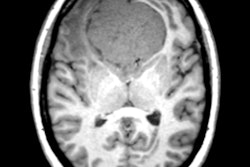
Don't underestimate chest x-rays as a useful technique for illuminating thoracic aorta pathologies, particularly when it comes to highlighting incidental findings, according to Italian research presented at last week's European Society of Cardiovascular Radiology (ESCR) congress in Milan.
The investigators sought to quantify the spread between the results of a two-view chest x-ray (CXR) and CT angiography (CTA) in the evaluation of thoracic aortic calcification (TAC) and/or enlargement. They retrospectively analyzed 18 patients (15 men, three women; age range 55 to 86, mean 74 years) who underwent both two-view chest x-rays (posteroanterior and lateral views) and a CTA scan within 365 days of each other.
The sample size was relatively small because CTA scans, including examinations of the thoracic aorta, make it possible to evaluate the lung parenchyma and other chest structures as well, and this means it is uncommon to require a chest x-ray if a CTA exam is planned or has already been performed. Therefore, in the sample, a clinical request for both imaging techniques mainly concerned emergency cases, such as suspected pneumonia and pneumothorax in chest x-rays, and aortic dissection or severe chest pain in CTA scans.
"In both imaging techniques the presence of TAC or lack thereof, and its enlargement or lack thereof, were analyzed by a radiologist separately, thus creating four possible outcomes for both pathologies: TAC could be evident or not in the CXR as well as in the CTA, and aortic enlargement could be evident or not in the CXR as well as in the CTA," explained lead author Dr. Alessio Mereu, from the department of radiology at Monserrato University Hospital in Cagliari, Sardinia.
The group performed statistical analysis of the previous four outcomes for both pathologies separately, considering CTA as the gold standard. Because all the subjects underwent both imaging techniques, McNemar's test was carried out to assess if there was a statistically significant difference between them; the level of significance was set to p values lesser than 0.05.
Using the same data, accuracy, Kappa statistic, negative and positive likelihood ratios, negative and positive predictive values, sensitivity, specificity, Youden's index, and their confidence intervals at the 95% level were evaluated. Calculation and statistical analysis were performed using R open source programming language version 3.4.1 (30 June 2017), on a Linux operating system.
A summary of the results for thoracic aortic calcification and enlargement are shown in the tables below.
| Thoracic aorta calcific atherosclerosis | ||
| Variable | Estimate | Confidence interval 95% |
| Accuracy | 0.722 | 0.465-0.903 |
| Kappa statistic | 0.416 | -0.017-0.848 |
| Likelihood ratio, negative | 0.385 | 0.152-0.971 |
| Likelihood ratio, positive | 3.462 | 0.578-20.735 |
| Predictive value, negative | 0.500 | 0.157-0.843 |
| Predictive value, positive | 0.900 | 0.555-0.997 |
| Sensitivity | 0.692 | 0.386-0.909 |
| Specificity | 0.800 | 0.284-0.995 |
| Youden's index | 0.492 | -0.331-0.904 |
| McNemar's test p-value | 0.371 | |
| Thoracic aorta enlargement | ||
| Variable | Estimate | Confidence interval 95% |
| Accuracy | 0.500 | 0.260-0.740 |
| Kappa statistic | 0.069 | -0.250-0.388 |
| Likelihood ratio, negative | 0.914 | 0.609-1.372 |
| Likelihood ratio, positive | 1.600 | 0.175-14.631 |
| Predictive value, negative | 0.467 | 0.213-0.734 |
| Predictive value, positive | 0.667 | 0.094-0.992 |
| Sensitivity | 0.200 | 0.025-0.556 |
| Specificity | 0.875 | 0.473-0.997 |
| Youden's index | 0.075 | -0.501-0.553 |
| McNemar's test p-value | 0.045 | |
Enlargement detection differed significantly statistically between chest x-ray and CTA, whereas thoracic aortic calcification detection did not. The Kappa statistic showed acceptable agreement for TAC detection and virtually nonexistent agreement for enlargement detection. Specificity was high in both evaluations, and this could be explained by considering that when those radiological findings are evident in the chest x-ray, it might be because of their relatively relevant size, according to Mereu and colleagues.
The study results show chest x-rays performed well compared with CTA in the detection of thoracic aortic calcification, and although it performed poorly in the detection of its enlargement, it demonstrated high specificity in both clinical situations.
"Calcification often is evident in a CXR because of its radiopacity, even if the extension is not very large; on the other hand, 3D aorta enlargement has to be pictured on a 2D image, which makes its detection somewhat harder, especially when its enlargement is relatively small in size," they concluded.
The group's full presentation from the ESCR 2017 meeting is available in the European Society of Radiology's EPOS database. To view it, click here.



















